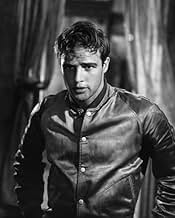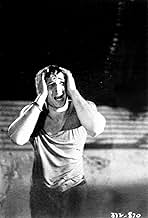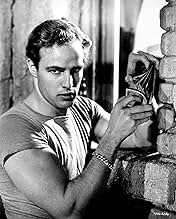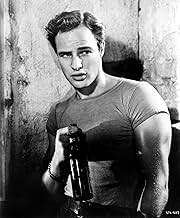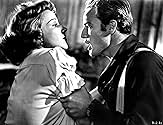A perturbada Blanche DuBois se muda com sua irmã em Nova Orleans e é atormentada por seu brutal cunhado.A perturbada Blanche DuBois se muda com sua irmã em Nova Orleans e é atormentada por seu brutal cunhado.A perturbada Blanche DuBois se muda com sua irmã em Nova Orleans e é atormentada por seu brutal cunhado.
- Ganhou 4 Oscars
- 22 vitórias e 15 indicações no total
James Adamson
- Extra
- (não creditado)
Irene Allen
- Extra
- (não creditado)
Mel Archer
- Foreman
- (não creditado)
Walter Bacon
- Club Patron
- (não creditado)
Dahn Ben Amotz
- Minor Role
- (não creditado)
Avaliações em destaque
Now that this filmization of "Streetcar" is over a half century old, it can be looked at in a more objective manner than that of the early fifties. The "classical/traditional" acting style of Vivien Leigh, which was placed in stark contrast to the rest of the production personnel, continues to hold its own brilliantly.
It's probably hard today for some to imagine the strong opposition Leigh's casting faced back in 1950, when this prim actress from England was chosen (mostly by studio chief Jack Warner) over "method" Broadway actress Jessica Tandy.
A goodly number of cast and production people from the hit play directed by Elia Kazan were engaged by the director for the film version, and they were not at all enthusiastic about risking a "clash" of acting styles in the leading, pivotal role of Blanche. Kazan himself was reportedly very pro-Tandy, and quite disappointed in the studio's decision.
Yet, Warner and his staff felt Tandy wasn't that well known to the general movie going public--especially in contrast to Leigh, whose marquee name was by then almost magical. In recent interviews, Kazan admitted that working with Vivien was "a real challenge."
In looking at the film today, however, it's Leigh who emerges as a genuine "star" of this production. True, her facial expressions, vocal inflections and body gestures may be the result of careful, deliberate planning, but so what? It's also the aspect that commands attention and draws the viewer to her portion of the screen throughout this film.
Her southern accent, so well learned and retained from her work as Scarlett in "GWTW," is convincing and very beautiful to hear. It also fits Blanche perfectly, as does Leigh's stylized "choreography," which was undoubtedly retained from her long-running London stage performance.
Not all the combined, formidable talents of "method" giants as Karl Malden, Kim Hunter, Marlon Brando or Kazan can diminish the hypnotic work of Leigh here. It may not have excited "Gadge" Kazan, but it remains a highlight performance in film history (and impressed the Academy enough to bestow an "Oscar" to Vivien.)
It also didn't hurt to have Alex North's pungent score, which remains this composer's finest hour.
It's probably hard today for some to imagine the strong opposition Leigh's casting faced back in 1950, when this prim actress from England was chosen (mostly by studio chief Jack Warner) over "method" Broadway actress Jessica Tandy.
A goodly number of cast and production people from the hit play directed by Elia Kazan were engaged by the director for the film version, and they were not at all enthusiastic about risking a "clash" of acting styles in the leading, pivotal role of Blanche. Kazan himself was reportedly very pro-Tandy, and quite disappointed in the studio's decision.
Yet, Warner and his staff felt Tandy wasn't that well known to the general movie going public--especially in contrast to Leigh, whose marquee name was by then almost magical. In recent interviews, Kazan admitted that working with Vivien was "a real challenge."
In looking at the film today, however, it's Leigh who emerges as a genuine "star" of this production. True, her facial expressions, vocal inflections and body gestures may be the result of careful, deliberate planning, but so what? It's also the aspect that commands attention and draws the viewer to her portion of the screen throughout this film.
Her southern accent, so well learned and retained from her work as Scarlett in "GWTW," is convincing and very beautiful to hear. It also fits Blanche perfectly, as does Leigh's stylized "choreography," which was undoubtedly retained from her long-running London stage performance.
Not all the combined, formidable talents of "method" giants as Karl Malden, Kim Hunter, Marlon Brando or Kazan can diminish the hypnotic work of Leigh here. It may not have excited "Gadge" Kazan, but it remains a highlight performance in film history (and impressed the Academy enough to bestow an "Oscar" to Vivien.)
It also didn't hurt to have Alex North's pungent score, which remains this composer's finest hour.
Blanche DuBois reminds me of Norma Desmond in Sunset Blvd. (1950). Both characters succumb to their alter egos, and descend into their own worlds of fantasy and half-truths.
In "A Streetcar Named Desire", Blanche travels from her antebellum roots in Mississippi to New Orleans, to see her sister Stella. But, upon arriving in the Big Easy, Blanche must confront Stella's husband Stanley, a greasy, poker-playing neanderthal lout who knows a thing or two about reality. It's the clash between Blanche's stately delusions and Stanley's gritty realism that soups up the drama in this Tennessee Williams play, converted to film classic by director Elia Kazan.
The drama is absorbing. But the performances of Marlon Brando and Vivien Leigh, as Stanley and Blanche, are what make the film the cinematic powerhouse that it is. Excellent B&W lighting and jazzy background music amplify the seedy, sleazy atmosphere, which adds depth and texture to the story and the acting. And, of course, the claustrophobic, steamy French Quarter makes a perfect setting.
As one would expect for a film derived from a play, "A Streetcar Named Desire" is very talky. Generally, I don't care for films burdened with a ten thousand page script. But this talk-fest is an exception. Overwhelming what I would otherwise consider a weakness, the acting of Brando and Leigh alone are enough to justify a two hour investment, and render an enjoyable and memorable cinematic experience.
In "A Streetcar Named Desire", Blanche travels from her antebellum roots in Mississippi to New Orleans, to see her sister Stella. But, upon arriving in the Big Easy, Blanche must confront Stella's husband Stanley, a greasy, poker-playing neanderthal lout who knows a thing or two about reality. It's the clash between Blanche's stately delusions and Stanley's gritty realism that soups up the drama in this Tennessee Williams play, converted to film classic by director Elia Kazan.
The drama is absorbing. But the performances of Marlon Brando and Vivien Leigh, as Stanley and Blanche, are what make the film the cinematic powerhouse that it is. Excellent B&W lighting and jazzy background music amplify the seedy, sleazy atmosphere, which adds depth and texture to the story and the acting. And, of course, the claustrophobic, steamy French Quarter makes a perfect setting.
As one would expect for a film derived from a play, "A Streetcar Named Desire" is very talky. Generally, I don't care for films burdened with a ten thousand page script. But this talk-fest is an exception. Overwhelming what I would otherwise consider a weakness, the acting of Brando and Leigh alone are enough to justify a two hour investment, and render an enjoyable and memorable cinematic experience.
When the history of American theater is written for the 20th Century the two most prominent names will be Eugene O'Neill and Tennessee Williams. Both men pushed the exploration of the human soul to the very limit in their work. Writing drama will never be the same because of the work of these two men.
Williams's masterpiece is A Streetcar Named Desire which ran over 860 performances in three years. When Warner Brothers bought the film rights, they did the highly unusual thing of bringing almost the entire Broadway cast over. That included Marlon Brando for whom this was his second film. Brando was not a movie name yet and the decision was made to recast the female lead with Vivien Leigh instead of Jessica Tandy who played Blanche Dubois on Broadway.
In doing so this gave Vivien Leigh the very unique position of having played opposite the two men who are held up as male acting icons for the last century, Marlon Brando and Leigh's husband at the time Laurence Olivier. Certainly Blanche Dubois was unlike anything she ever did opposite Olivier.
In fact Blanche is opposite that other southern belle that Leigh got her first Oscar for, Scarlett O'Hara. Scarlett may come on like a spoiled brat at first, but she turns out to be made of some real stern stuff when the chips are down.
Blanche Dubois however retreats into her own fantasies when trouble brews. She's left the plantation home in a small Mississippi town where she doubles as an English teacher and comes to live with her sister Stella and her husband Stanley Kowalski.
Brando is Kowalski and for years impressionists did him by yelling from the pit of their abdomens, "STELLA, STELLA." That is until The Godfather and then they stuffed their cheeks and said how one day a favor would be asked in return.
But impressionists only make a living because of the impressions made by the players. On Broadway and Hollywood, Stanley Kowalski made Marlon Brando a superstar and an icon for a couple of generations. Kowalski as done by Brando is a force of nature, primeval impulses that bubble to the surface in all of us sometimes.
Kim Hunter as Stella Kowalski and Karl Malden as Mitch Mitchell also won Oscars in the Supporting categories to go with Leigh's. Hunter is a torn women fighting both suspicions about her husband and her sister. The real reason why Blanche has come to live with them and the affect her silly flirtations are having on her husband and their marriage.
Malden as Mitchell starts out as passive and as nice as Jim Connor, the gentleman caller from that other Tennessee Williams masterpiece, A Glass Menagerie. But he proves to be something less than meets the eye in his dealings with Leigh.
A Streetcar Named Desire won all kinds of Awards, the three acting Oscars, one for Elia Kazan as Best Director and a whole bunch of technical ones. But An American In Paris won for Best Picture and Hollywood decided young Brando could wait for his and they gave it that year to Humphrey Bogart for The African Queen.
This film is still the best adaption to the screen of a Tennessee Williams play and is an absolute must to see.
Williams's masterpiece is A Streetcar Named Desire which ran over 860 performances in three years. When Warner Brothers bought the film rights, they did the highly unusual thing of bringing almost the entire Broadway cast over. That included Marlon Brando for whom this was his second film. Brando was not a movie name yet and the decision was made to recast the female lead with Vivien Leigh instead of Jessica Tandy who played Blanche Dubois on Broadway.
In doing so this gave Vivien Leigh the very unique position of having played opposite the two men who are held up as male acting icons for the last century, Marlon Brando and Leigh's husband at the time Laurence Olivier. Certainly Blanche Dubois was unlike anything she ever did opposite Olivier.
In fact Blanche is opposite that other southern belle that Leigh got her first Oscar for, Scarlett O'Hara. Scarlett may come on like a spoiled brat at first, but she turns out to be made of some real stern stuff when the chips are down.
Blanche Dubois however retreats into her own fantasies when trouble brews. She's left the plantation home in a small Mississippi town where she doubles as an English teacher and comes to live with her sister Stella and her husband Stanley Kowalski.
Brando is Kowalski and for years impressionists did him by yelling from the pit of their abdomens, "STELLA, STELLA." That is until The Godfather and then they stuffed their cheeks and said how one day a favor would be asked in return.
But impressionists only make a living because of the impressions made by the players. On Broadway and Hollywood, Stanley Kowalski made Marlon Brando a superstar and an icon for a couple of generations. Kowalski as done by Brando is a force of nature, primeval impulses that bubble to the surface in all of us sometimes.
Kim Hunter as Stella Kowalski and Karl Malden as Mitch Mitchell also won Oscars in the Supporting categories to go with Leigh's. Hunter is a torn women fighting both suspicions about her husband and her sister. The real reason why Blanche has come to live with them and the affect her silly flirtations are having on her husband and their marriage.
Malden as Mitchell starts out as passive and as nice as Jim Connor, the gentleman caller from that other Tennessee Williams masterpiece, A Glass Menagerie. But he proves to be something less than meets the eye in his dealings with Leigh.
A Streetcar Named Desire won all kinds of Awards, the three acting Oscars, one for Elia Kazan as Best Director and a whole bunch of technical ones. But An American In Paris won for Best Picture and Hollywood decided young Brando could wait for his and they gave it that year to Humphrey Bogart for The African Queen.
This film is still the best adaption to the screen of a Tennessee Williams play and is an absolute must to see.
Blanche Dubois arrives in the French Quarter of New Orleans suffering from a mental tiredness brought on by a series of financial problems that have ended in the family losing their plantation. She has come to stay with her sister, Stella and her husband Stanley Kowalski in their serviceable little apartment. The aggressive and animalistic Stanley immediately marks himself as the opposite of the feminine and refined Blanche and Stella finds herself pulled between the two of them. Stanley suspects all is not as it seems and begins to pry into Blanche's colourful past, even as Blanche spots a way out in the arms of the Mitch, a man captivated by her. However it doesn't take long before the cracks begin to show in the relationships and in Blanche herself.
It almost goes without saying that the writing here is of top-notch quality. The story is a relatively simple character piece that can be summed up in a couple of sentences, however this would do a great injustice to the depth of development and the convincing manner in which the characters are all written and the story told. It is not so much the depth that some of the characters go to, but the complexity that is effortlessly written into them we can see it writ large on them, but not to the point where it seems obvious or uninteresting. Blanche is of course the focus and she is a mess of neurosis barely hidden behind a front of respectability that clearly doesn't convince her anymore than it does Stanley. Mitch is also really well written at first it is comic that he tries to be such a gentleman while having the brute just under the surface, but later his frustration is heavy on his face along with his anger. The overall story is surprisingly, well, "seedy" is the best word that comes to mind. It is in the gutter and no matter what Blanche wants to believe, that is where it stays and the film is right there the whole time.
How Kazan managed it in the early fifties is beyond me, because even now the film is pretty graphic in its violence to women, subject matter and rippling sexuality across pictures and characters. It is a compelling story due to the characters and the manner in which they are delivered Kazan's atmospheric direction really helps; the films feels humid and close, and he has done it all with a basic set and a camera. The lighting throughout is wonderful both in the general atmosphere but also specific touches such as the way Blanche manages to visibly age due to lighting changes when the film has slight chances of tone.
Of course the main reason I keep coming back to this wonderful film is the actors, who take the opportunity and, in many cases, make it so that it is hard to see anyone else playing their roles. Leigh is perfect for the role and gets everything absolutely spot on; she is vulnerable yet self-seeking, confident yet needy, proper yet unstable. Even visually Leigh is convincing in terms of body language but also the fact that she looks the right mix of ages, looking beautiful one moment but worn and defeated the next totally, totally deserved her Oscar. Brando made his name here and even now his performance is electrifying and memorable. He has his big scenes where he gets to play to the back row but he also has moments where he does nothing other than be a presence on screen; no matter what is going on we are watching him because we are as in awe and yet as afraid of his power as Blanche is herself. Together Leigh and Brando dominate the screen and whenever either of them are on screen it is hard to look away. As a result, Kim Hunter sort of gets lost in the background although her performance is still good. Karl Madden is great but again only holds a supporting role and deserved his Oscar for a convincing performance of a well-written character. Of course it is easier to give good performances with great material than with bad material but there have been enough versions of this play around for us to see how lesser actors can fail where this cast soared.
Overall this is a great film that sees so many critical aspects all coming together as one final product. A superb play has undergone a great adaptation that has been seized upon a great cast who deliver a collection of performances that deserve all the praise heaped on them, all directed with a real sense of atmosphere that really delivers a seedy and erotic film both for its time and today. I cannot think of an excuse for people not having seen this film.
It almost goes without saying that the writing here is of top-notch quality. The story is a relatively simple character piece that can be summed up in a couple of sentences, however this would do a great injustice to the depth of development and the convincing manner in which the characters are all written and the story told. It is not so much the depth that some of the characters go to, but the complexity that is effortlessly written into them we can see it writ large on them, but not to the point where it seems obvious or uninteresting. Blanche is of course the focus and she is a mess of neurosis barely hidden behind a front of respectability that clearly doesn't convince her anymore than it does Stanley. Mitch is also really well written at first it is comic that he tries to be such a gentleman while having the brute just under the surface, but later his frustration is heavy on his face along with his anger. The overall story is surprisingly, well, "seedy" is the best word that comes to mind. It is in the gutter and no matter what Blanche wants to believe, that is where it stays and the film is right there the whole time.
How Kazan managed it in the early fifties is beyond me, because even now the film is pretty graphic in its violence to women, subject matter and rippling sexuality across pictures and characters. It is a compelling story due to the characters and the manner in which they are delivered Kazan's atmospheric direction really helps; the films feels humid and close, and he has done it all with a basic set and a camera. The lighting throughout is wonderful both in the general atmosphere but also specific touches such as the way Blanche manages to visibly age due to lighting changes when the film has slight chances of tone.
Of course the main reason I keep coming back to this wonderful film is the actors, who take the opportunity and, in many cases, make it so that it is hard to see anyone else playing their roles. Leigh is perfect for the role and gets everything absolutely spot on; she is vulnerable yet self-seeking, confident yet needy, proper yet unstable. Even visually Leigh is convincing in terms of body language but also the fact that she looks the right mix of ages, looking beautiful one moment but worn and defeated the next totally, totally deserved her Oscar. Brando made his name here and even now his performance is electrifying and memorable. He has his big scenes where he gets to play to the back row but he also has moments where he does nothing other than be a presence on screen; no matter what is going on we are watching him because we are as in awe and yet as afraid of his power as Blanche is herself. Together Leigh and Brando dominate the screen and whenever either of them are on screen it is hard to look away. As a result, Kim Hunter sort of gets lost in the background although her performance is still good. Karl Madden is great but again only holds a supporting role and deserved his Oscar for a convincing performance of a well-written character. Of course it is easier to give good performances with great material than with bad material but there have been enough versions of this play around for us to see how lesser actors can fail where this cast soared.
Overall this is a great film that sees so many critical aspects all coming together as one final product. A superb play has undergone a great adaptation that has been seized upon a great cast who deliver a collection of performances that deserve all the praise heaped on them, all directed with a real sense of atmosphere that really delivers a seedy and erotic film both for its time and today. I cannot think of an excuse for people not having seen this film.
10Rathko
There is little to be said about this movie that thousands of critics have not stated already. It is a magnificent piece of cinema, with an intricate script delivered by actors at the peak of their talents. Leigh is unbearably brittle and fragile and she dances precariously on the edge of sanity. Marlon Brando embodies a sense of brooding masculinity that other men can only dream of attaining, while creating an enduring cinema icon and delivering one of the all-time great movie lines. From the raucous jazz score to the sleazy production design bathed in smoldering grey, 'Streetcar' is a class-act from beginning to end; sexy, brutal, and endlessly fascinating.
Você sabia?
- CuriosidadesAs the film progresses, the set of the Kowalski apartment actually gets smaller to heighten the suggestion of Blanche's increasing claustrophobia.
- Erros de gravaçãoWhen Stanley comes back from taking Stella to the hospital, he is looking for a bottle opener. He finds it on the mantelpiece, shakes up a bottle of beer, and opens it. The beer foams up and spills on his trousers. But if you watch at the moment when he swings himself up to sit on the table - before he opens the bottle - you can see that the front of his trousers are already wet. Apparently they re-shot it without him changing into dry trousers.
- Versões alternativasThe scene in which Blanche and Stanley first meet was edited a bit to take out some of the sexual tension that both had towards each other when the film was first released in 1951. In 1993, this footage was restored in the "Original Director's Version" of the film. The three minutes of newly-added footage sticks out from the rest of the film because Warner Brothers did not bother to restore these extra film elements along with the rest of the movie, leaving them very scratchy due to deterioration.
- ConexõesEdited into Un Américain nommé Kazan (2018)
- Trilhas sonorasIt's Only a Paper Moon
(1933) (uncredited)
Music by Harold Arlen
Lyrics by E.Y. Harburg and Billy Rose
Sung by Vivien Leigh while doing her hair
Principais escolhas
Faça login para avaliar e ver a lista de recomendações personalizadas
Detalhes
- Data de lançamento
- País de origem
- Idiomas
- Também conhecido como
- Un tranvía llamado Deseo
- Locações de filme
- Nova Orleans, Louisiana, EUA(railway station)
- Empresas de produção
- Consulte mais créditos da empresa na IMDbPro
Bilheteria
- Orçamento
- US$ 1.800.000 (estimativa)
- Faturamento bruto mundial
- US$ 54.695
- Tempo de duração2 horas 2 minutos
- Cor
- Proporção
- 1.37 : 1
Contribua para esta página
Sugerir uma alteração ou adicionar conteúdo ausente

Principal brecha
What was the official certification given to Uma Rua Chamada Pecado (1951) in Japan?
Responda






